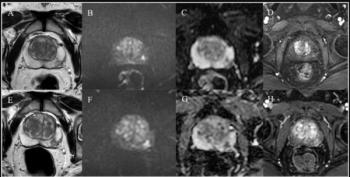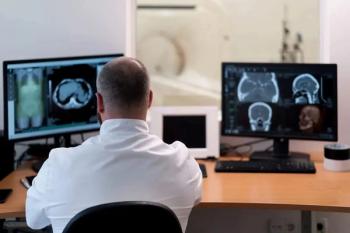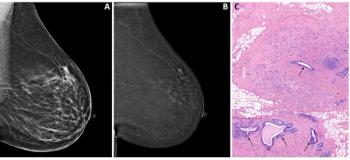
- Diagnostic Imaging Vol 31 No 12
- Volume 31
- Issue 12
Assessing tissue stiffness may boost breast imaging specificity
For many years, ultrasound has had a defined and very limited role in breast evaluations, being used for neither diagnosis nor detection.
For many years, ultrasound has had a defined and very limited role in breast evaluations, being used for neither diagnosis nor detection. The reasons were bundled together in the phrase “operator dependence.” Factors contributing to the operator dependence included small, 5-cm² field-of-view; acoustic speckle and a coarse, noisy image; poor, inconsistent scanning technique; inexperience with ultrasound depiction of breast anatomy and pathology; no standard for lesion analysis and reporting until publication of BI-RADS for ultrasound;1 and diagnostic use limited to cyst versus solid mass.2
The specificity and sensitivity of breast ultrasound were regarded as inadequate for differentiating benign from malignant solid masses and for detection of cancers not palpable or identifiable on mammograms. Since the FDA gave premarket approval to the L10-5 linear broadband-width transducer for distinguishing benign from malignant etiologies in 1996,3 now nearly 15 years ago, technical advances have permitted use of ultrasound for many new applications. More important is the increasing confidence in breast diagnoses made using this modality, whose technical advances have been striking.
Nevertheless, the specificity issue remains, and although standardization of lesion assessment through BI-RADS feature analysis has supplied three morphologic features that, taken together, suggest a benign etiology-oval shape, circumscribed margin, and orientation parallel to the skin-masses with these features are still frequently biopsied; their histopathologies are found to be benign, as expected. Like the perpetual hunt for the Fountain of Youth, a dependable talisman has been the object of this specificity quest.
Could elasticity assessment be the answer? Elastography has been proposed as a way of augmenting specificity for many years. More than two decades ago, Jonathan Ophir at the University of Texas studied elastography and proposed its use in the clinical realm. Fifteen years ago, Brian Garra at the University of Vermont studied a small number of breast lesions with elastography, publishing his results in Radiology.4 Although work continued in the background, only in recent years have tissue stiffness gauges of various types been incorporated in a number of high-resolution linear transducers, allowing elastography to become an efficient and easy-to-perform component of the breast ultrasound examination.
21ST CENTURY PALPATION
How can tissue stiffness be measured? Tissue stiffness has always been assessed during physical examination. The examining hand palpates textural differences between a mass and its surrounding tissues, and when the mass is discrete, fingers can be placed around it and its size estimated (commonly using fruit and nuts for communication; e.g. pea-size, walnut-size, lemon-size). In addition, manual compression allows the clinician to feel its softness or deformability, which may be affected by the softness of the tissue above it, subcutaneous fat in many instances. Also evaluated is the mobility of a breast mass, or whether it is fixed to the tissue harboring it. Elastography, which can be performed with ultrasound or MRI, can be considered a 21st century e-physical examination technique.
TESTING TISSUE STIFFNESS
Different techniques have been developed for visualizing the mechanical properties of soft biological tissues in vivo.
For correlation-based elasticity and tissue Doppler-based elasticity-strain imaging-the basic technique is to use the transducer's face to compress the tissue and then release it. Compression and release may be performed several times so that a representative cycle can be selected for analysis. Deformity of the lesion may be observed with B-mode imaging, the mass may appear thinner and wider, for example, but softness or firmness is most often displayed via a color spectrum that overlies the image.
For the compression-release methods, appropriate technique must be practiced. This involves control of the amount of compression, timing of the compression and release sequence, and the rhythm of multiple compressions applied to the tissue. At no time should the force of compression be so great as to cause the patient pain or discomfort. The lesion must be kept in view during the process. The results are reported to be reproducible.5,6 Burnside detailed her early experience using Siemens' Antares and commented on the significant operator dependence she observed.7 Siemens' more recent elastographic technique relies on signal variations from cardiac and respiratory activity and shear wave–types of pulses into tissue more than on manual compression and release of the transducer at the skin, although a gentle excursion is still recommended.
A novel approach to elasticity assessment with ultrasound has been developed at SuperSonic Imagine (Aix-en-Provence, France). This method sends shear waves into tissue. Shear waves are transverse waves induced within solids subjected to shear. They transiently change shape without changing volume or density. When a lesion has been identified, the operator hovers with the transducer over the lesion for a few seconds, with no pressure other than the probe making contact with the skin, and activates the shear wave button on the console. Slow shear waves (travelling at speed less than 10 m/sec in tissue) are induced in tissue and their pattern is captured by ultrafast imaging, with the entire process taking fewer than 20 msec. This requires an acquisition frame rate on the order of more than 5000 Hz.
The stiffness of the tissue can be measured in kPa and is represented by a spectrum ranging from dark red (very stiff) through orange, yellow, and green, to blue (very soft). Outside of the U.S., a stiffness number is recorded for the lesion as well as a ratio between the lesion, most often a mass, and a reference tissue, such as fat (the quantitative measurements in kPa have not yet received FDA clearance as of today, but the shear wave elastography map displays tissue stiffness in its color spectrum).
SuperSonic Imagine is sponsoring a multicenter trial with North American and European sites using a prototype system. A lesion is first evaluated with a clinically approved system, and a feature analysis is performed to obtain a BI-RADS assessment category. The B-mode examination is repeated on the SuperSonic Imagine system (a prototype system being used for the study). A box is drawn about the lesion in dual-frame mode and color Doppler is applied. In the same box three separate elastograms are recorded, so that intraperformer consistency can be ascertained, from which reproducibility may be inferred. The type, heterogeneity, and size of the elastograms are recorded, as are the B-mode characteristics.
Preliminary analysis of the first 1000 cases of this ongoing study, which will be completed in late 2009 or early 2010, suggests that elastography may augment the specificity obtained through BI-RADS' morphologic feature analysis. For example, a small circumscribed hypoechoic mass of midlevel kPa stiffness was originally given a BI-RADS 3 (probably benign) assessment. But the broader, multicolor, irregularly shaped color overlay demonstrated on elastography caused it to be elevated to 4a. When biopsied with ultrasound guidance, it was found to be an invasive ductal carcinoma.
When all of the study data are analyzed against the biopsy results and follow-up imaging of the lesions distributed through BI-RADS 2 to 5, application of the elasticity assessment may make it possible to downgrade a 4a to a 3, or a 3 to a 2. For patient safety, these potential changes in patient management, less costly and less invasive as they are, await confirmatory data.
The typical B-mode morphologic and benign elastographic appearances are shown in Figures 1 and 2, and the most common pattern for cancer is shown in Figure 3. In two instances, shear waves do not propagate: in cysts and complicated cysts the lower portion of the lesion may be black, indicating absence of shear waves. More dramatic is the blackness of large irregularly shaped carcinomas, which reject the shear waves but show no ambiguity in their malignant B-mode features and the large multicolor elastographic pattern that surrounds the mass (Figure 3).
What is suggested by the first 1000 cases are possible diagnostic criteria for transient shear wave elastography: for cancers and other suspicious lesions, irregular shape dissimilar to that of the lesion, heterogeneous color, and an elastogram frequently of larger size than the lesion; for benign lesions, often a blue mass within a blue background, with similar size and shape of the elastogram and B-mode image.
Need for standardization
Although most manufacturers of ultrasound systems have developed or are engaged in developing techniques to asses strain or stiffness-or both-as attributes of masses, and although their methods are variable, some standardization of display is in order to avoid interpretive confusion.
Most methods use color overlays to depict their stiffness patterns, although some show elastograms in black and white to display the relative stiffness of the lesion compared with the tissues surrounding it. Although any color can be arbitrarily assigned to any level of stiffness, there has been no standardization, and interpretation would be facilitated if red were chosen as stiff. Red is the color of stop signs in the Western world, and it should be associated with a suspicious and firm lesion. At the other end of the spectrum is blue, a better choice for soft lesions.
Although work in ultrasound-related elastography commenced more than 20 years ago, its incorporation in the current high-resolution broad-bandwidth linear probes used for insonating breast tissue is exciting. The elastograms take no more than an extra two minutes to do, and they may help to reduce the number of false-positive interpretations of morphologically indeterminate masses. They may also increase suspicion for those masses resembling complicated, or even simple, cysts whose B-mode appearance may appear beguilingly benign-those pseudocircumscribed, round, anechoic-to-hypoechoic masses with posterior acoustic enhancement.
Of course, some cancers are soft and some benign fibrotic areas, such as scars, are stiff. But without expecting a magic answer to all of our questions, we can anticipate that specificity in lesion interpretation will improve, and that the next version of BI-RADS for ultrasound, publication of which is slated for late 2010, may contain another feature category: elasticity assessment.
Articles in this issue
almost 16 years ago
Critical results still go unnoticed on patient EMRalmost 16 years ago
University of Virginia opens center for ablation researchalmost 16 years ago
Coronary CTA exposes plaque risk for diabeticsalmost 16 years ago
Contrast media reactions rarely happen, study findsalmost 16 years ago
Women who skip mammo face higher risk of deathalmost 16 years ago
Rads urge cautious CT use for swine flu workupalmost 16 years ago
Berger urges imagers to be stewards of radiologyalmost 16 years ago
Disaster survivors show early signs of traumatic stressalmost 16 years ago
fMRI lights up gap between consciousness and cognitionalmost 16 years ago
A reply from Dr. Leonard BerlinNewsletter
Stay at the forefront of radiology with the Diagnostic Imaging newsletter, delivering the latest news, clinical insights, and imaging advancements for today’s radiologists.






























